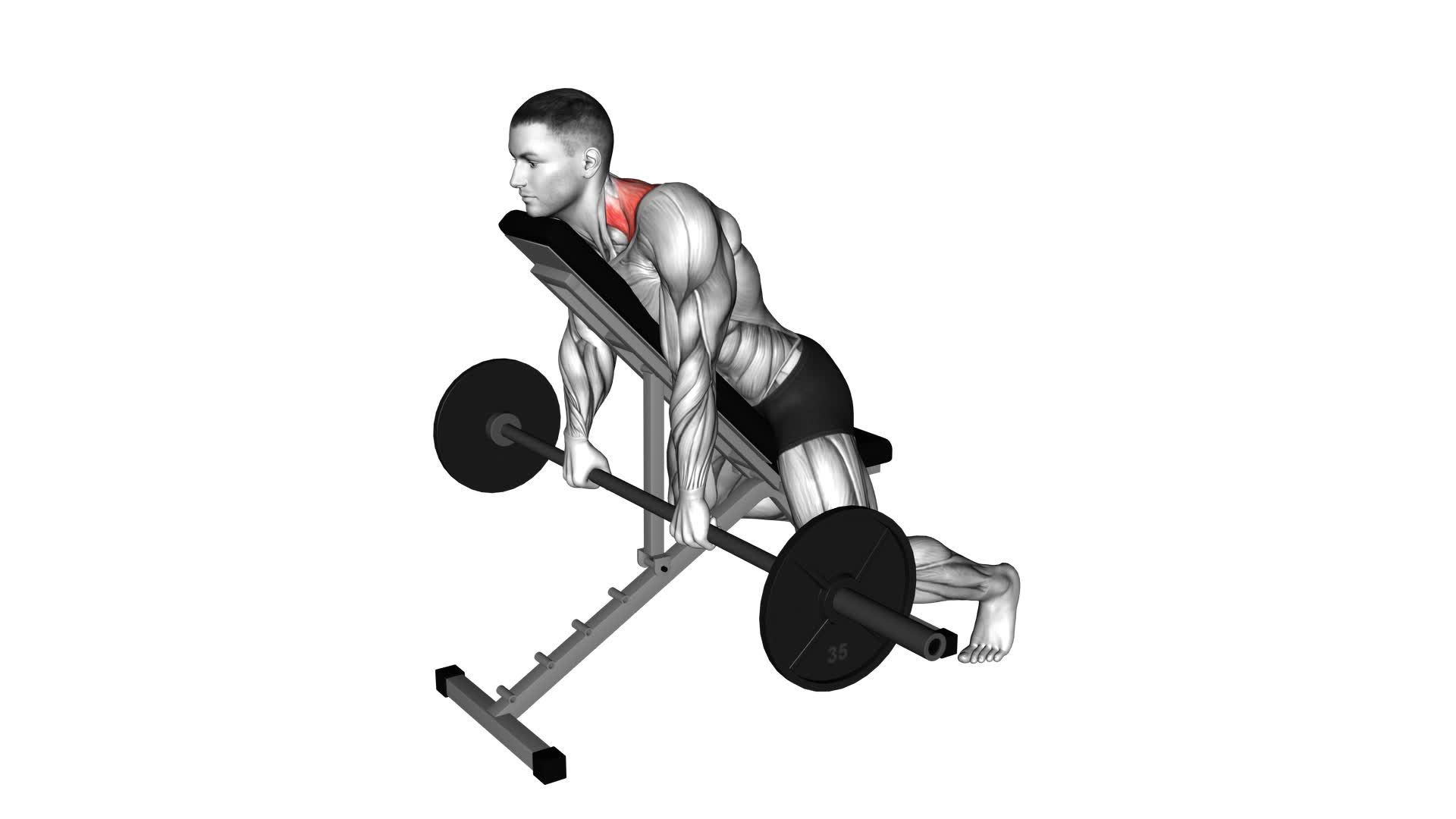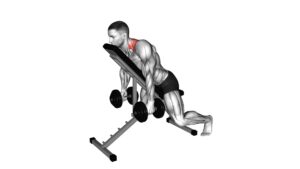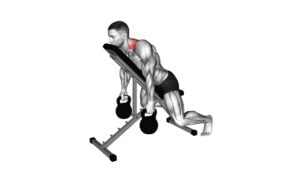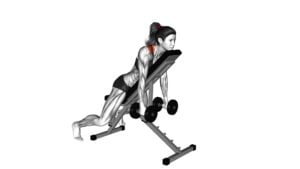Barbell Decline Shrug – Video Exercise Guide & Tips

Are you looking to strengthen your traps and build upper body strength? The barbell decline shrug is an effective exercise that targets those specific muscles.
Watch This Exercise Video
In this video exercise guide, you'll learn the proper form and technique, as well as tips for choosing the right weight and avoiding common mistakes.
Maximize your results and take your workouts to the next level with the barbell decline shrug.
Let's get started!
Key Takeaways
- The barbell decline shrug strengthens traps and builds upper body strength.
- It targets muscles in the upper back and shoulders, stabilizing shoulder joints and improving posture.
- The exercise helps prevent injuries, especially for activities with repetitive shoulder movements.
- By improving shoulder strength and stability, it enhances athletic performance.
Benefits of the Barbell Decline Shrug
Discover the numerous benefits of incorporating the barbell decline shrug into your workout routine. This exercise isn't only effective in building strength and muscle in your upper back and shoulders, but it also plays a crucial role in injury prevention and muscle activation.
One of the key benefits of the barbell decline shrug is its ability to prevent injuries. By strengthening the muscles in your upper back and shoulders, this exercise helps to stabilize your shoulder joints and improve your overall posture. This can be particularly beneficial for individuals who engage in activities that require repetitive shoulder movements, such as weightlifting or throwing sports.
Additionally, the barbell decline shrug is highly effective in activating the muscles in your upper back and shoulders. The movement involved in this exercise targets the trapezius muscles, which are responsible for shoulder movement and stability. By activating these muscles, you can improve your shoulder strength and stability, which can have a positive impact on your overall athletic performance.
Incorporating the barbell decline shrug into your workout routine can provide you with a range of benefits, including injury prevention and improved muscle activation. By regularly performing this exercise, you can strengthen your upper back and shoulders, enhance your posture, and improve your overall athletic performance.
Proper Form and Technique
To perform the barbell decline shrug properly, use a firm grip on the barbell and maintain a strong, stable position. Start by lying face down on a decline bench with your feet secured. Grasp the barbell with an overhand grip, slightly wider than shoulder-width apart. Keep your arms fully extended and your elbows slightly bent throughout the movement.
As you lift the barbell, focus on retracting your shoulder blades and squeezing your traps at the top of the movement. This will help to improve muscle activation and target the upper back and shoulder muscles more effectively. Make sure to maintain control and avoid using excessive momentum.
To add variation to your barbell decline shrugs, you can experiment with different hand grips. Using an underhand grip or a neutral grip can shift the emphasis to different muscle groups, such as the biceps or the middle and lower trapezius.
If you find the barbell decline shrug too challenging, you can modify the exercise by using dumbbells instead. This allows for a greater range of motion and can be more comfortable for individuals with wrist or shoulder issues.
Choosing the Right Weight
Now let's move on to determining the appropriate weight for your barbell decline shrugs. Choosing the right weight is important to ensure proper form and maximize the benefits of this exercise. Here are some tips to help you select the appropriate weight:
- Start with a weight that allows you to perform the exercise with proper form and technique.
- Gradually increase the weight as you get stronger and more comfortable with the movement.
- Use the principle of progressive overload by gradually increasing the weight over time to continue challenging your muscles.
- Pay attention to your body and listen to any signs of discomfort or pain. If you experience any, reduce the weight or seek guidance from a fitness professional.
Safety precautions should be taken when choosing the weight, such as ensuring the weight is securely fastened to the barbell and using collars to prevent plates from slipping off.
Common Mistakes to Avoid
To avoid common mistakes, make sure you're aware of proper form and technique while performing barbell decline shrugs.
One common misconception is that you need to use heavy weights to get the most out of this exercise. However, using excessive weight can lead to poor form and increase the risk of injury. It's important to start with a weight that allows you to maintain proper form throughout the movement.
Another mistake to avoid is rounding your shoulders forward during the shrug. This can put unnecessary strain on your neck and upper back. Instead, focus on pulling your shoulders back and down, squeezing your shoulder blades together at the top of the movement. This will help target the muscles of the upper back more effectively.
Additionally, some people mistakenly believe that the barbell decline shrug can only be done on a decline bench. While the decline bench provides a greater range of motion, you can also perform this exercise on a flat bench or even standing. These alternative variations can help target the muscles from different angles and provide additional challenge.
Tips for Maximizing Results
To maximize your results, implement these key tips when performing the barbell decline shrug:
- Use proper form: Maintain a straight back, engage your core, and keep your shoulders relaxed during the exercise. This will ensure that you're targeting the intended muscles effectively.
- Gradually increase weight: Start with a weight that challenges you but allows for proper form. As you progress, gradually increase the weight to continue challenging your muscles and maximizing gains.
- Incorporate workout variations: Add variety to your routine by trying different grip widths or using dumbbells instead of a barbell. This will target different muscle fibers and prevent plateaus.
- Focus on the negative phase: Slowly lower the weight back to the starting position, emphasizing the eccentric contraction. This will increase time under tension and stimulate further muscle growth.
- Rest and recover: Allow your muscles to rest and recover between workouts. This will prevent overtraining and promote muscle growth.
By following these tips, you can maximize your gains and achieve better results from your barbell decline shrug workouts. Remember to listen to your body and adjust the weight and intensity as needed.
Incorporating workout variations and prioritizing proper form will help you continually challenge your muscles and avoid plateaus. Rest and recovery are also crucial for optimal muscle growth. So implement these tips into your routine and take your barbell decline shrugs to the next level.
Frequently Asked Questions
What Are Some Alternative Exercises to the Barbell Decline Shrug?
Looking for alternative exercises to the barbell decline shrug?
Two great options are the dumbbell decline shrug and the cable decline shrug. These exercises target the same muscles as the barbell decline shrug, but offer a different variation and range of motion.
The dumbbell decline shrug involves using dumbbells instead of a barbell, while the cable decline shrug utilizes a cable machine.
Both exercises can help strengthen your traps and upper back.
How Often Should I Incorporate the Barbell Decline Shrug Into My Workout Routine?
To properly perform the barbell decline shrug, incorporate it into your workout routine 1-2 times per week.
This exercise targets your trapezius muscles, helping to improve upper body strength and posture. By regularly including the barbell decline shrug, you can enhance your overall shoulder and back development.
Remember to use proper form and gradually increase the weight to avoid injury. Consulting with a fitness professional can also ensure you're incorporating this exercise correctly.
Can the Barbell Decline Shrug Help With Improving Posture?
The barbell decline shrug is a great exercise for improving posture. By targeting the upper back muscles, it helps strengthen the muscles responsible for maintaining an upright posture.
This exercise also engages the trapezius muscles, which play a key role in shoulder stability and proper alignment.
Incorporating the barbell decline shrug into your workout routine can have numerous benefits for your posture, leading to improved overall alignment and reduced risk of postural imbalances.
Is It Necessary to Use a Decline Bench for This Exercise, or Can It Be Done on a Flat Bench?
Using a flat bench for the barbell decline shrug isn't necessary for this exercise. While it's traditionally performed on a decline bench, you can also do it on a flat bench.
The decline bench angle allows for a greater range of motion, targeting the lower traps and shoulder muscles more effectively. However, using a flat bench can still provide benefits to your shoulder muscles.
It's important to maintain proper form and use a challenging weight to maximize results.
Are There Any Specific Muscles That the Barbell Decline Shrug Targets?
The barbell decline shrug targets specific muscles in your upper back and traps. It helps to strengthen and build these muscles, improving your posture and upper body strength.
If you're looking for alternative exercises, you could try the dumbbell decline shrug or the cable face pull. Both of these exercises target similar muscle groups and can provide similar benefits.
Incorporating the barbell decline shrug into your workout routine can help you achieve a stronger and more defined upper body.
Conclusion
To conclude, the barbell decline shrug is a highly effective exercise for targeting and strengthening the upper back and shoulder muscles.
By maintaining proper form and technique, choosing the appropriate weight, and avoiding common mistakes, you can maximize your results from this exercise.
Remember to consult with a fitness professional or trainer if you have any concerns or questions.
Incorporate the barbell decline shrug into your routine for improved upper body strength and stability.

Author
Years ago, the spark of my life’s passion ignited in my mind the moment I stepped into the local gym for the first time. The inaugural bead of perspiration, the initial endeavor, the very first surge of endorphins, and a sense of pride that washed over me post-workout marked the beginning of my deep-seated interest in strength sports, fitness, and sports nutrition. This very curiosity blossomed rapidly into a profound fascination, propelling me to earn a Master’s degree in Physical Education from the Academy of Physical Education in Krakow, followed by a Sports Manager diploma from the Jagiellonian University. My journey of growth led me to gain more specialized qualifications, such as being a certified personal trainer with a focus on sports dietetics, a lifeguard, and an instructor for wellness and corrective gymnastics. Theoretical knowledge paired seamlessly with practical experience, reinforcing my belief that the transformation of individuals under my guidance was also a reflection of my personal growth. This belief holds true even today. Each day, I strive to push the boundaries and explore new realms. These realms gently elevate me to greater heights. The unique combination of passion for my field and the continuous quest for growth fuels my drive to break new ground.







